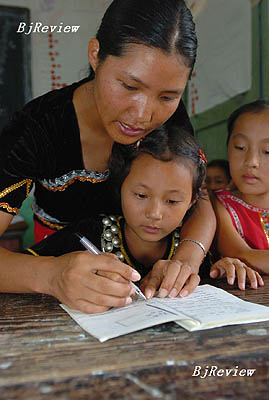| 
At least 1 billion Chinese people have mastered the use of pinyin, or the Chinese phonetic system, the most common romanization system of mandarin in use, as it celebrates its 50th anniversary in February.
Pinyin is formally called hanyu pinyin. Hanyu means the Chinese language, pin means "spell" and yin means "sound."
After the founding of the People's Republic of China in 1949, the government put the creation of a new romanization system of mandarin high on its work agenda. In 1955, a subcommittee was founded under the language reform committee and was given the specific task of drafting the pinyin system. The public submitted 655 versions of the pinyin system, whose drafts were published by the official newspaper People's Daily. In February 1958, the National People's Congress, China's top legislature, ratified the final version of the pinyin system. In the fall semester of 1958, the teaching of pinyin was written into the textbooks of first grade students in primary schools. Since then, about 90 percent of people who have received schooling have learned pinyin.
The pinyin system superseded older romanization systems such as Wade-Giles, which is still used in Taiwan, and Chinese Postal Map Romanization, and replaced zhuyin as the method of Chinese phonetic instruction introduced in the 1910s. In 1982, hanyu pinyin was voted by the International Organization for Standardization as the standard romanization for modern Chinese. It has also been accepted by the Government of Singapore, the Library of Congress, the American Library Association and many other international institutions.
Pinyin has become the basis for Chinese version of Braille, sign language and flag language in China. It has also become a useful tool for entering Chinese language text into computers and cellphones.
The five mascots for the Beijing 2008 Olympics, which were initially called "Friendlies," were renamed "Fuwa," a literal Chinese pinyin translation. For many Chinese the new name is more acceptable and easy to understand.
China also published the Xinhua Dictionary and Modern Chinese Dictionary, setting rules for using pinyin to spell people's names and places.
"Pinyin has proved very useful in helping foreigners to learn oral Chinese," said Lu Jianming, Professor of modern Chinese language at Peking University and head of the International Society for Chinese Language Teaching. But he said mastering writing the only pictogram-based major language in the world remains difficult as the written language, Chinese characters, is very different to other written languages. He believes that the absolute majority of foreign Chinese learners will not seriously study Chinese characters, which would enable second language learners to read Chinese texts on paper.
As for how to promote the learning of Chinese worldwide, Ma Qingzhu, a professor of the Chinese language at Tianjin-based Nankai University, was quoted by Tianjin Daily in February, saying that he intended to invent a pinyin-based spelling tool that will empower foreign Chinese learners to read texts."This would be a major step to guarantee the existence of the Chinese language in foreign countries," Ma said.
Something You May Not Know About Pinyin
Economics professor and renowned linguist Zhou Yongguang, who celebrated his 102nd birthday on January 13, is the only surviving creator of the pinyin system. As a member of the reform panel on the Chinese language and a professor of the Chinese Academy of Social Sciences in the 1950s, he put forward three principles of the pinyin system, which was publicized in 1958. He also presided over the formulation of basic rules for pinyin orthography, which was publicized in 1988. Zhou witnessed the International Organization for Standardization adopt pinyin as the standard romanization for modern Chinese in 1979.
Law on the Standard Spoken and Written Chinese Language, the first law of its kind, was adopted in October 2000. The law states, "Where foreign languages need to be used in publications in Chinese, necessary explanatory notes in standard Chinese shall be applied."
For those Chinese who speak Standard Mandarin at home, pinyin is used to help children associate characters with spoken words, which they already know. So in the pictures helping kids to learn pinyin letters, the picture for "a" is a baby, as its pronunciation is similar to the sound of a baby; the picture for "o" is a rooster, as it likes the sound of a rooster crowing in the morning.
The Windows Vista system includes three simplified Chinese input styles. Under sentence-based input, a pinyin syllable is converted into a Chinese character automatically when you start typing the next one. Using the phrase-based input, couples of unconverted pinyin syllables display simultaneously in the reading window. Word-based input is designed on the basis of the Intelligent ABC Input Method, developed under the lead of Professor Zhu Shoutao at Peking University. When using the ABC input style, there is no auto-conversion from pinyin to Chinese characters. Instead, the candidates are selected by pressing the space bar or enter.
| 